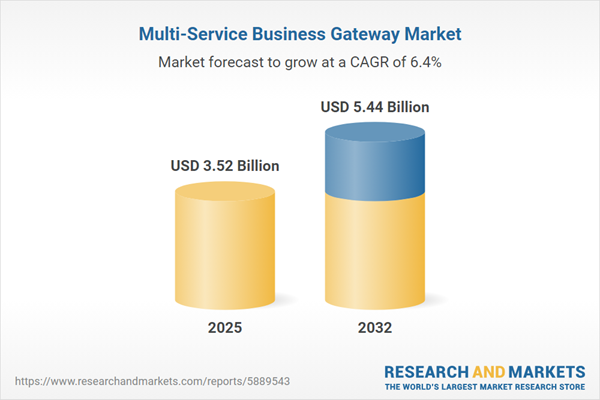Speak directly to the analyst to clarify any post sales queries you may have.
Multi-service business gateways are foundational for enterprises navigating digital transformation. They unify network management and strengthen security, enabling organizations to scale efficiently and adapt rapidly to dynamic technology and compliance requirements. Leaders evaluating strategic IT investments increasingly turn to these gateways to future-proof their infrastructure and maintain business agility.
Market Snapshot: Multi-Service Business Gateway Market Overview
The global multi-service business gateway market shows robust and steady growth as enterprises elevate their investment in integrated network solutions and advanced cybersecurity. In 2024, the market is valued at USD 3.31 billion, with projections pointing to USD 3.52 billion in 2025 and reaching USD 5.44 billion by 2032, underlining a strong upward trajectory. This increase is shaped by the urgent need for seamless connectivity, robust defenses against emerging threats, and agile operations for organizations with decentralized or hybrid workforces. Industry leaders continuously refine gateway technologies to address shifting compliance demands and industry-specific requirements, with deployments spanning legacy and modern IT environments worldwide.
Scope & Segmentation
- Deployment Models: Choices include cloud-based gateways—compatible with public, private, or hybrid architecture—and on-site solutions tailored to demanding regulatory or operational conditions.
- Service Types: Core functions like secure internet access, support for multiple VPNs, and unified communications enable effective collaboration and remote work for geographically distributed teams.
- Components: Enterprise-grade hardware such as routers and switches is integrated with management platforms for centralized oversight and enhanced data security.
- Industry Verticals: Sectors such as banking, insurance, government, healthcare, IT, telecom, and retail implement bespoke gateway configurations to address distinct compliance and productivity imperatives.
- Connectivity Types: Advanced technologies including 5G, LTE, broadband, fiber optics, MPLS, satellite, and microwave provide stable, high-performance connections for various organizational settings—from cities to remote areas.
- Applications: Businesses use gateways to secure IoT integration, enable virtualized networking, permit remote enterprise access, and facilitate scalable communication tools, including video conferencing for global teams.
- Regions Covered: Research encompasses North America, Europe, Asia-Pacific, the Middle East, and Africa, accounting for regional infrastructure maturity and investment drivers unique to each market.
- Key Companies: Cisco Systems, Huawei Technologies, Nokia, Juniper Networks, ZTE Corporation, ADTRAN, Calix, ARRIS International, Technicolor SA, and Fortinet are among the principal technology providers advancing innovation, with significant influence on market direction.
Key Takeaways: Strategic Insights for Senior Decision-Makers
- Consolidated gateway platforms streamline network oversight and security management, reducing operational complexity as regulations evolve globally.
- Cloud-first and hybrid infrastructures empower organizations to flexibly align resources and scale IT efficiently with project or workload changes.
- AI and machine learning integration increases proactive network defense, accelerates threat identification, and enhances network stability as enterprises grow.
- Central data analytics supports swift response to incidents and maintains reliable service delivery for teams distributed across multiple regions.
- Custom gateway solutions help address diverse compliance mandates and support quick market entry in varied industry and regional contexts.
- Ongoing vendor collaboration encourages solution innovation, ensuring enterprise network systems remain adaptive and ready for future technology shifts.
Tariff Impact: Navigating Trade Policy and Supply Chain Dynamics
Adjustments in global trade policies and fluctuating tariffs directly affect sourcing strategies for hardware and semiconductors supporting the multi-service business gateway market. Manufacturers mitigate potential risks through supply chain diversification, boosting regional production capacity, and evolving logistics models. These actions help maintain steady technology availability and safeguard enterprise operations amid international economic changes.
Methodology & Data Sources
This research synthesizes perspectives from in-depth interviews with industry experts, technical assessment of gateway solution architectures, and comprehensive structured datasets. Data triangulation, scenario modeling, and revenue validation methodologies underpin a rigorous and objective evaluation of market dynamics.
Why This Report Matters
- Senior IT and procurement leaders gain clear, actionable insight into gateway deployment options and evolving supplier ecosystems, supporting strategic acquisition planning.
- The report empowers proactive network investment by identifying critical supply chain and compliance drivers influencing enterprise infrastructure choices.
- Granular segmentation by application, sector, and region enables tailored gateway strategies closely aligned to both operational and regulatory priorities.
Conclusion
Multi-service business gateways are integral to modernizing digital infrastructure and reinforcing network security, enabling organizational growth and adaptability. Their flexibility supports compliance, positioning enterprises for sustained success in increasingly complex digital markets.
Additional Product Information:
- Purchase of this report includes 1 year online access with quarterly updates.
- This report can be updated on request. Please contact our Customer Experience team using the Ask a Question widget on our website.
Table of Contents
3. Executive Summary
4. Market Overview
7. Cumulative Impact of Artificial Intelligence 2025
Companies Mentioned
The companies profiled in this Multi-Service Business Gateway market report include:- Cisco Systems, Inc.
- Huawei Technologies Co., Ltd.
- Nokia Corporation
- Juniper Networks, Inc.
- ZTE Corporation
- ADTRAN, Inc.
- Calix, Inc.
- ARRIS International PLC
- Technicolor SA
- Fortinet, Inc.
Table Information
| Report Attribute | Details |
|---|---|
| No. of Pages | 197 |
| Published | November 2025 |
| Forecast Period | 2025 - 2032 |
| Estimated Market Value ( USD | $ 3.52 Billion |
| Forecasted Market Value ( USD | $ 5.44 Billion |
| Compound Annual Growth Rate | 6.3% |
| Regions Covered | Global |
| No. of Companies Mentioned | 11 |









